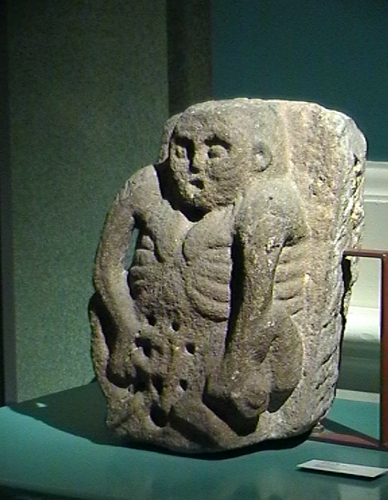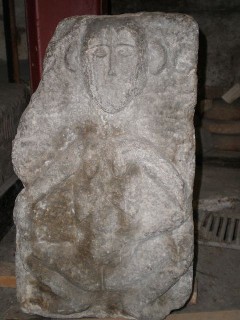
On a trip to Ireland several years ago, I was fortunate to have been able to see the Sheela-na-gigs in the National Museum of Dublin. Two of these Sheelas including the one removed from the Seir Kieran Church of County Offaly, pictured below, are currently on display. They stand at the doorway of a room dedicated to items from the medieval period and easily missed. As there was little interest in them and they are not in cases, I was able to silently commune without interruption.
.
We also had the opportunity to see one Sheela in situ at Killinaboy Church in County Clare.

A great deal of controversy surrounds the meaning of the Sheelas and the reasons why they are often found in rural churches. Our Irish guide at Killinaboy seemed embarrassed by the one perched above the doorway of the church. After having spent twenty minutes discussing a Celtic cross, she devoted about two minutes to the Sheela which she said was a warning against the sin of lust. This prominent scholarly opinion is repeated in the book Sheela-na-Gigs by Eamonn Kelly published in conjunction with the museum.
Sheelas are carved images of women who point to their swollen or enlarged vulvas. Closer inspection reveals that most of them are bald with large skull-like heads and small sometimes sagging breasts; some of them also have prominent rib cages. Whereas others have been disgusted, frightened, and repelled by the Sheelas, I felt calm and comforted in their presence. Touching them and cradling them in my hands, I felt a sweetness about them.
Taking inspiration from female scholars Margaret Murray, Edith Guest, and Marija Gimbutas. Barbara Freitag in her book Sheela-na-Gigs argues that the Sheelas must be understood in the context of medieval folk religion. She sees the swollen vulvas of the Sheelas as depictions of women in the process of giving birth: the Sheelas thus were propitious symbols that women may have touched or turned to for protection. But what about their more frightening death-like upper parts? Frietag believes that the Sheelas were also images of the death.
The seeming contradiction between the life and death images is resolved once it is understood that in pre-Christian religions birth, death, and renewal were understood to be parts of a single process. This may explain their symbolism but why were they placed in churches? Frietag suggests that the Sheelas were incorporated into church architecture because the people would not abandon them. Usually they were placed in a position where they could not be touched, decorated, or anointed. Incorporation was a step towards control and eventual eradication.
Eradication was never complete. Frietag was able to document the existence of 167 Sheelas in Ireland, Scotland, Wales, and England. Some of these are now missing and many show signs of deliberate defacing. Those that have remained can still speak to us across the centuries of the sacredness of the female body and of our human connection to the processes of birth, death, and regeneration in all of life. They call us to honor our bonds with our mothers and our Mother, the earth.
At least nine or ten Sheelas are stored in the basement of the National Museum of Dublin. As I had come to Dublin as part of the World Archaeology Conference, my request to see them was granted. My friend Naomi and I were left alone with seven Sheelas not on loan at the time of our visit for nearly an hour.
I had a kind of mystical experience in the shadowy depths of the basement of the museum with the Sheela-na-gigs: I suddenly noticed that some of them seemed to be dancing. The Burgesbeg Sheela seems to be leaping or jumping: her toes are pointed and her feet do not touch the ground.

The Ballylarkin Sheela—whose pose is usually described as “sitting on her hunkers”—seemed to be about to spring up into the leap of the Burgesbeg Sheela or to have just landed.

As my vision continued, I saw old women on dark nights at holy wells, sacred trees, and graveyards joyously leaping and jumping while displaying their vulvas. They were warning the Christians: “Don’t forget the Mother.” Christians who had forgotten the female Source of Life might have viewed such women as frightening, disgusting, or mad. But those who had not forgotten would, I imagined, have smiled and given them a wink.
Was my vision far-fetched? Barbara Freitag cites an early twentieth century report of a ritual dance at a holy well. “The women, with garments fastened right up under their arms and with hands joined, were dancing in a circle round the well. An aged crone sat in their midst, and dipping a small vessel in the water, kept sprinkling them. They were married women who had proved childless and had come to the well to experience its fertilizing virtues.”
I do not believe that Christians created the Sheelas as images of the sin of lust, as is often argued. The Sheelas are too powerful in their own right for that to be true. Some priests may have removed Sheelas from pagan holy places and set them above the doors rural churches as warnings against rituals they hoped to eradicate. To them, the Sheelas might have symbolized the sin of Eve. But the Irish love a good joke. I like to think of them thumbing their noses at the priests as they walked under the Sheelas silently affirming: “We will not forget.”
Originally published in slightly different form in two parts on the now disappeared Women of Wisdom blog in 2009. Photos by Naomi Goldenberg.
For information on Ireland’s Sheelas see http://www.irelands-sheelanagigs.org/.
Also see Starr Goode’s recently published Sheela na gig: The Dark Goddess of Sacred Power.
For a wider perspective, see Miriam Robbins Dexter and Victor Mair, Sacred Display: Divine and Magical Female Figures.


I see these figures as nature as Goddess appearing in her darker aspect warning us NOT TO FORGET THAT OUR BODIES BRING FORTH LIFE AT ALL STAGES…I think Carol’s vision was a gift offered because she understood at a heart level how important these figures were and are – life death renewal – in these times we can take comfort FROM this reality
LikeLiked by 1 person
Synchronous posting! I am preparing a talk on Wells in the Hebrew Bible for the Association for the Study of Women and Mythology next month, and plan to contrast the Hebrew view with the Pagan/Christian symbolism. I will incorporate this interpretation, the fertilizing virtues of the waters of a sacred well.
LikeLiked by 1 person